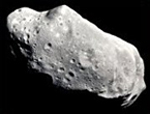LINEAR
Mission
Lincoln Near Earth Asteroid Research (LINEAR) is an MIT Lincoln Laboratory program funded by the United States Air Force and NASA. The goal of LINEAR is to demonstrate the application of technology originally developed for the surveillance of Earth orbiting satellites, to the problem of detecting and cataloging near-Earth asteroids—also referred to as near-Earth objects (NEOs)—that threaten the Earth.
Data Collection Method
The project uses a pair of Ground-based Electro-Optical Deep Space Surveillance (GEODSS) telescopes at Lincoln Laboratory's Experimental Test Site (ETS) at the White Sands Missile Range in Socorro, New Mexico. The telescopes are equipped with Laboratory-developed charge-coupled device (CCD) electro-optical detectors and collected data is processed onsite to generate observations. Observations are then sent to the main Lincoln Laboratory facility at Hanscom AFB in Lexington, Massachusetts, where they are linked from night to night, checked, and sent to the Minor Planet Center (MPC). The MPC assigns designations to LINEAR's new discoveries of NEOs, comets, unusual objects, and main belt asteroids.
LINEAR Observations, Detections, and New Discoveries
Totals as of September 15, 2011 |
|
| Observations to MPC | 30,446,690 |
| Total Detections | 7,380,528 |
| All Discoveries | 231,082 |
| NEO Discoveries | 2,423 |
| Comet Discoveries | 279 |
Naming Minor Planets—The Ceres Connection
MIT Lincoln Laboratory has partnered with Society for Science & the Public to promote science education through the Ceres Connection program. This program seeks to name minor planets after students in fifth through twelfth grades and their teachers.
All minor planets named in the Ceres Connection program have been discovered by LINEAR. See the Ceres Connection site for more information on the specific process for naming minor planets and to view the names of honorees.

